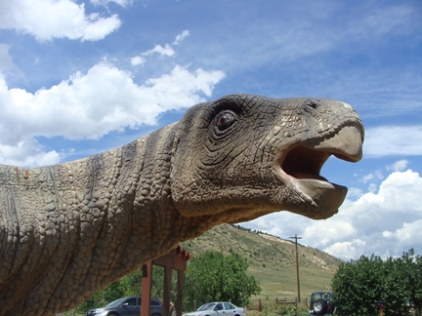
This is an image of a herbivorous dinosaur, the apatosaurus, which traversed the earth more than 200 million years ago near Red Rocks Park and Morrison, Colorado.
Dinosaurs walked the earth less than 10 miles from where I now live in Colorado, with proof at Dinosaur Ridge, just east of the Red Rocks Amphitheater where many of the world’s finest musicians perform on any given night on any given summer. Rock stars and real rock stars. The visitor center seemed small, but it was ample to move adult and midget dinosaur-hunters to guided tours or self-guided tours. The gift shop is very cool, if you are into rocks, geodes, geology or dinosaurs. And if you want the real poop on Dinosaur Ridge, well, you can buy it there.
Outside the visitor center was a play area with replicas of the dinosaurs that roamed there more than 250 million years ago. The Stegosaurus Snack Shack was alluring, but did not feature Stegosaurus-on-a-stick, so I passed.

The rippled areas in these photos were formerly the sea bed of the Western Interior Seaway, which covered much of the Western half of the United States.
The most surprising thing I learned is that most of Colorado, a semi-arid climate, was once covered by seawater and prehistoric sea life. So maybe there were real Rocky Mountain Oysters.
As the story goes, reptilian sea monsters of incredible size frolicked in this inland sea before geological disturbances caused the sea to dry up and the Rocky Mountains, as we know them, to jut from the earth. The area is rich with other geological anomalies, including the massive deposit of Benton Shale, iron-stained rock formations and concretions, which are naturally occurring balls that form in rocks.
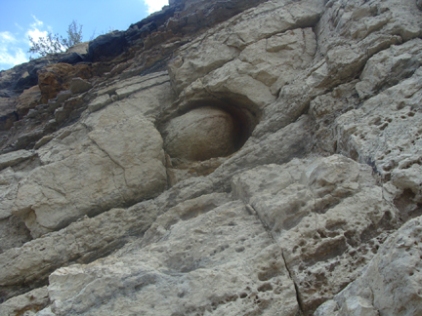
This concretion is visible from the road that splits a cleft in the Dakota Ridge, where the dinosaurs used to roam.
Another geological novelty is the visual remnant of volcanic ash sediment that covered the area millions of years ago.
The highlight of the natural exhibit are the dinosaur tracksite. More than 300 adult and baby dino tracks have been discovered on the eastern slope, sometimes called the “Dinosaur Freeway.” This slope was once the sandy beach adjacent to the Western Interior Seaway, and a species called iguanodon migrated freely between what is now Colorado and New Mexico.

The Dinosaur Ridge tracks are shaded for visual effect. The Iguanodon who left the tracks ran mostly on their toes, leaving distinguishable fossil imprints. Often, these quadrupeds moved upright, using only their hind legs.
As you cross through a cleft in the Dakota Ridge to the west side, numerous geological oddities present themselves. In the layers of rock sediment, a three-inch thick white stripe identifies a point in the timeline when the area was covered in volcanic ash.
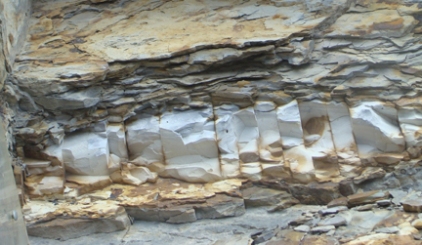
Volcanoes in Colorado? Apparently so, many millions of years ago. The white stripe in the sediment indicates an era where this region was covered in volcanic ash. I’m pretty sure it was reported on KUSA.
Further along the western slope is where the prehistoric deer and apatosaurus played. Enough bones were found in the Morrison range to create accurate anatomical evidence of the apatosaurus, allosaurus and stegosaurus. The actual bones are displayed at the Peabody Museum in Boston, since the primary discoverers were from the geology department at Yale University. Some of the petrified bones remain embedded in the mountainside. I was able to touch a stegosaurus hip and protective bony spike. Later, as school-aged children touched the remains, a tour guide revealed that they are radioactive. Isn’t this how comic-book superheroes are born?
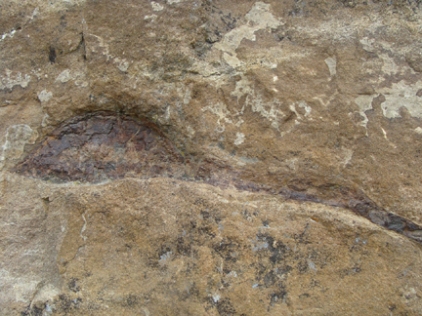
Stegosaurus bones, the official state fossil of Colorado and the reason for the purple dinosaur mascot for the Colorado Rockies. The bones are darker than the surrounding rock. The bone matter is glossy and slick-feeling compared to the sandstone.
Many of the dinosaur tracks and fossil remains were discovered in the 1800s, and more were unearthed in the 1940s when the mountainside was excavated to build the road. The Morrison site, now officially known by the USGS as Dinosaur Ridge, is the most significant dinosaur find in North America, excluding Friday nights at the Old Country Buffet..
In the early 1800s, dinosaur remains were discovered by a farmer named Moody near the Rooney farm. Then, in 1877, a Colorado geologist named Arthur Lakes made the most significant dinosaur bone finds. In the past decade, Barry Manilow’s orthopedic surgeon performed a hip replacement surgery and discovered bones older than those in Morrison, but that doesn’t diminish the Dinosaur Ridge legend.
The Dinosaur Ridge lore includes a story of larceny and suspense. After the dinosaur tracksite was discovered in the 1940s, nothing happened. They were left unprotected for three decades. In that time, one of the dinosaur fossils was chiseled from the earth, in every sense of the word. It was stolen. Efforts to find the missing relic failed. In the past two years, the dino footprint was returned to its rightful owners.
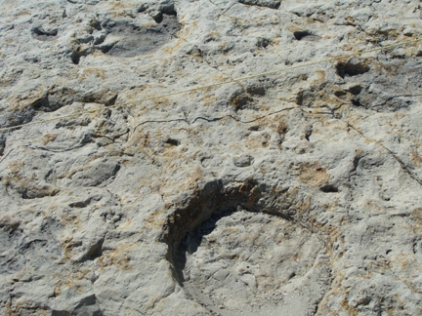
One dinosaur track was chiseled from the earth and later found being used as a doorstop at Colorado State University in Fort Collins.
The pilfered prehistoric property was being used as a doorstop in a dormitory at Colorado State University. More than fifty years later, the relic was turned into the natural sciences department at the college. After collecting dust there for a few years, it was returned to Dinosaur Ridge about a year ago. Damn college kids!
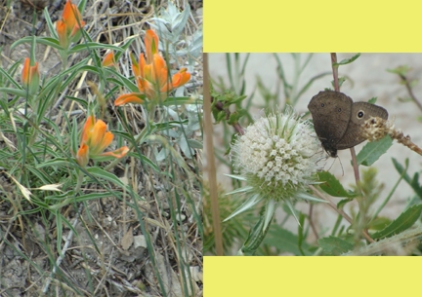
Wildflowers and flying critters. The Dakota Trail is also a haven for raptors — hawks, falcons, eagles and vultures.
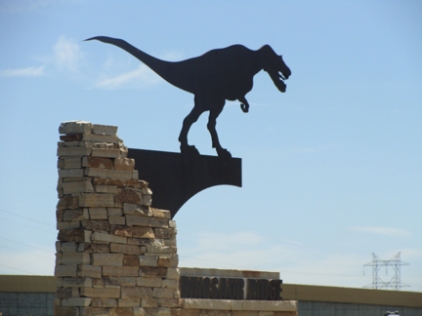 The entire hike was about 2.4 miles. My Achilles tendon was screaming afterward, but it was an enjoyable, enlightening afternoon. I did not visit the Triceratops Trail in Golden. That will be an adventure for another day.
The entire hike was about 2.4 miles. My Achilles tendon was screaming afterward, but it was an enjoyable, enlightening afternoon. I did not visit the Triceratops Trail in Golden. That will be an adventure for another day.

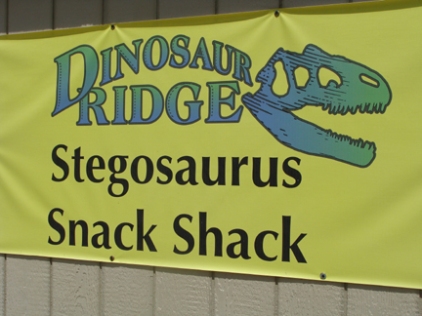

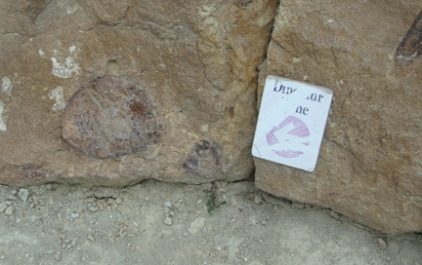
Leave a comment